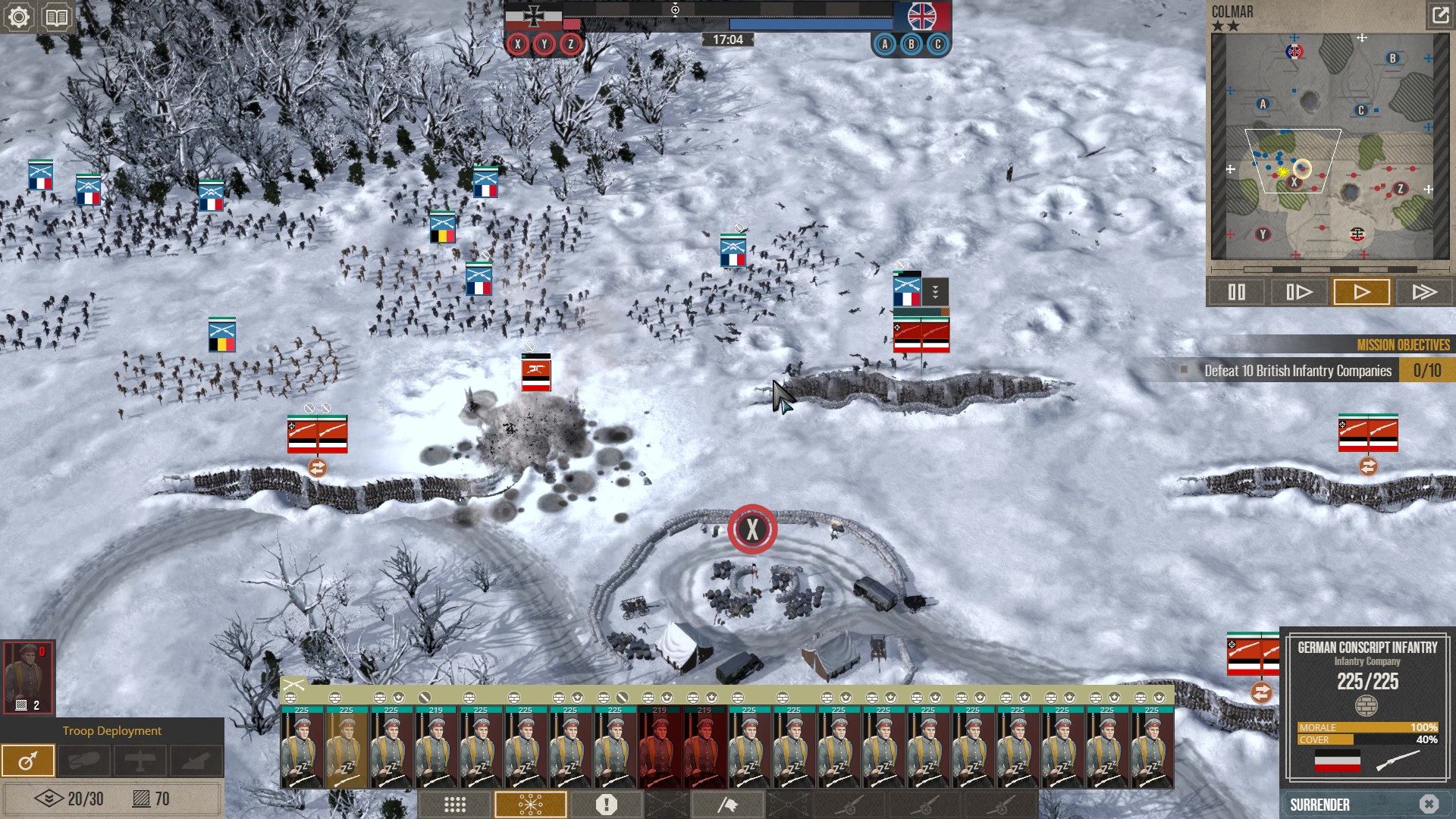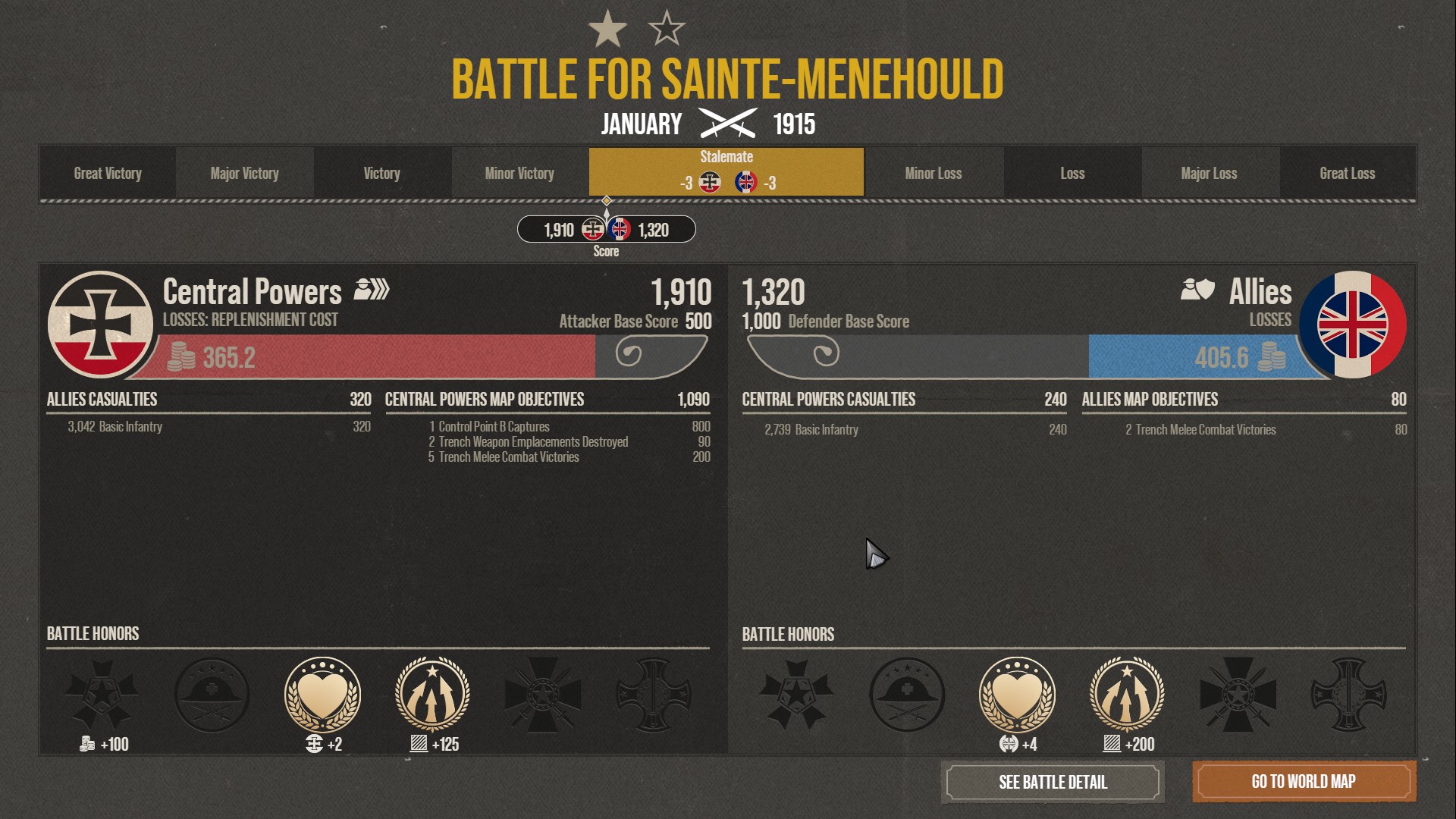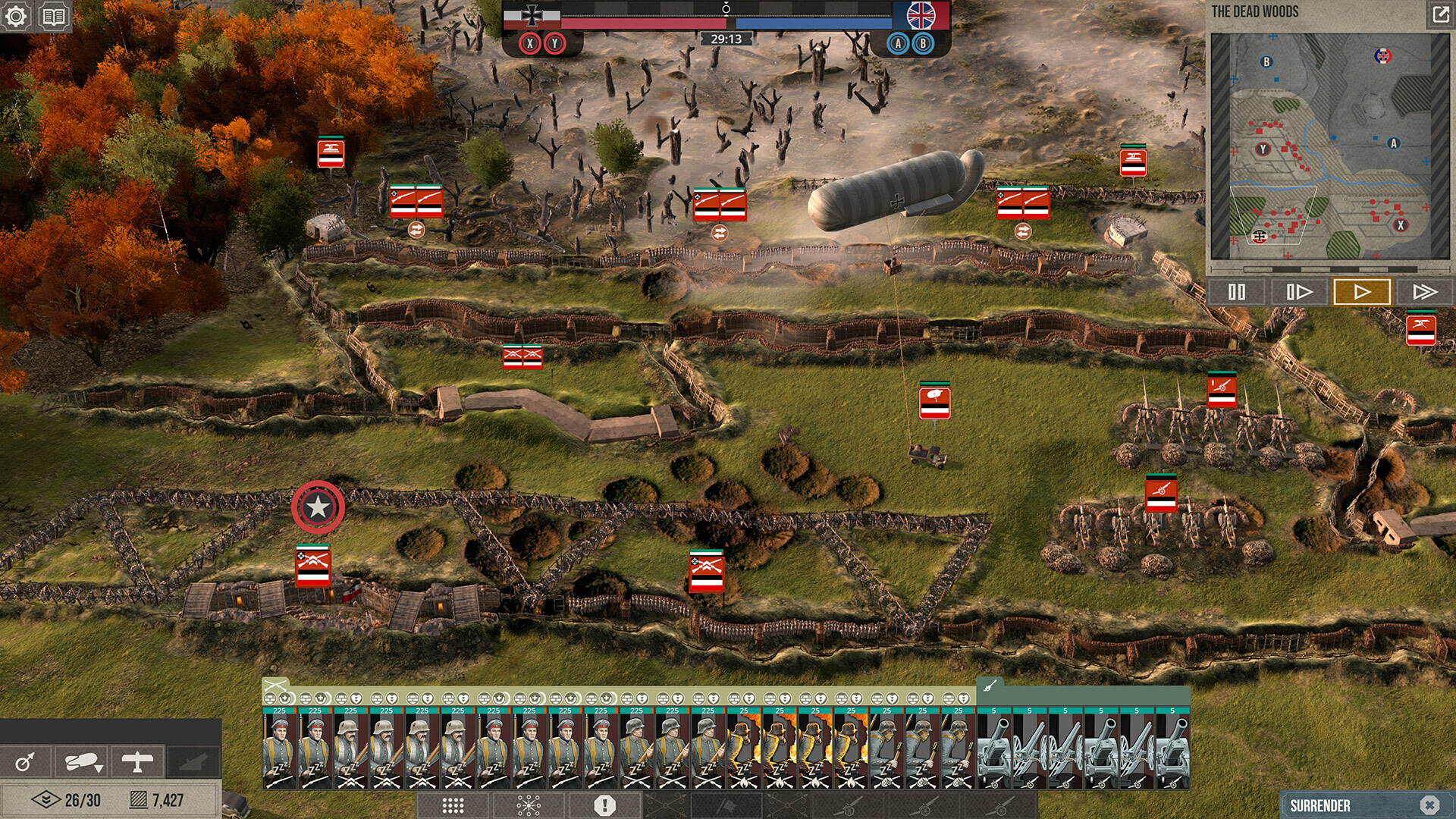Our Verdict
The Great War: Western Front is a bleak, conservative attempt to capture the brutal battles of World War I.
PC Gamer's got your back
What is it? A slow-paced, real-time strategy game set in the horrific fires of World War I's Western Front.
Expect to pay: £29.99/$34.99
Release date: Out now
Developer: Petroglyph Games
Publisher: Frontier Foundry
Reviewed on: Windows 10, Nvidia GeForce RTX 2070 Super, Intel Core i7-9700 @ 3.00GHz, 16GB RAM
Multiplayer? Yes
Link: Official site
The Great War: Western Front is not a real-time strategy game for perfectionists. World War I was infamously attritional, claiming the lives of 40 million civilians and military personnel. So, when you sound the whistle and send your boys over the top, dozens of them will be gunned down in the hellish muck of no man's land, with machine gun emplacements able to casually eradicate whole companies in a matter of seconds.
That makes this game something of an outlier compared to its more bloodless peers. Company of Heroes veterans relish the sweatless gratification of an expert counterflank, and there are few joys comparable to a Mutalisk rout in StarCraft. But in The Great War, every victory comes with a brutal death toll. The terrors of 1914 shine white and hot, and, quite frankly, they might make you hesitant to stick around for long.

As the name implies, The Great War: Western Front takes place entirely within the fortifications that sliced through Belgium and France in the 1910s. Players are greeted by a grand, tabletop-ish tactics board in the campaign, where they marshal the regiments of either the Allies or the Central Powers along the frontlines. Those interstitial moments are spent assigning research points, bolstering munitions, and breaking ground on new installations that make the terrors of mechanized warfare slightly more palatable—a medical facility, a makeshift pub, and so on.
Pyrrhic victory
But commanders can only beat around the bush for so long. Eventually it is time to act and spill your troops into enemy territory for marginal gains and gristly carnage. This is where Western Front morphs into a sorrowful, Total War-esque dirge in battlefields pockmarked with dug-out trenches and makeshift chokepoints, all the better to pick off the rival troops. Any successful engagement requires a sturdy line of heavy artillery, which can suppress advancements and shatter morale. But most importantly, you need to muster the full war machine of Europe; a phalanx of flesh and bone. Western Front does not deal in squads or special operations. Instead, a tide of humanity smashes against the opposing earthworks until they finally capitulate.
All of this viscera leaves a hell of an impression. Compared to games that have evoked the spirit of 1914, (Battlefield 1, Isonzo, Beyond The Wire) Western Front takes an active role in dispiriting all of us armchair generals with a wealth of gnarly decisions. Victory in The Great War is achieved by capturing and holding a series of control points, and the simplest way to ascertain that condition is by laying down a blast of mortar shells to briefly paralyze the gunner nests before sending a few waves of men hurtling through wide-open, cover-bereft mud and snow. Dozens of them will be annihilated before they make it to their objective, and those that do will need to clear the enemy headquarters—sandbag by sandbag—before finally wrestling authority of the arena. As a strategist, it's often hard to know if I'm doing a good job in Western Front. Yes, a few acres of land now fly under the Allied flag, but the veritable mountain of writhing bodies behind me certainly looks like a loss.

As you progress through Western Front's tech tree, more combat wrinkles become available, mildly augmenting the action on the field. You can leverage the rudimentary airforce of the era, dispatching AI-controlled bombing runs and intercepting forces to conquer the gray skies above. More advanced artillery barrages lay on the horizon as you delve deeper into the war; I'm particularly fond of a punishing, rolling bombardment that slowly encroaches upon enemy positions, while leaving a long trail of smoke behind that covers your own advancements. The armor divisions are also quite powerful, if only because a tank can effectively puncture the best-laid reinforcements.
If the bombs explode at the wrong moment, and the enemy lines aren't suppressed as your troops come into view, you can reasonably expect to be wiped out.
Despite all of those fun ingredients, Western Front is surprisingly rote in its delivery method. The shells fire, the battalions charge, and you hope to not be outmaneuvered or outflanked by your adversary. In fact, I'd say that the majority of the game's decisions come down to a matter of pure timing. If the bombs explode at the wrong moment, and the enemy lines aren't suppressed as your troops come into view, you can reasonably expect to be wiped out. Few strategy games are more eager to punish your blunders.
This would be less of an issue if Western Front had a touch more fidelity in its controls. Soldiers move at a turgid, Napoleonic pace, and despite the relative straightforwardness of my objectives, they'd often get bogged down in some strange patches of mouse-click vagueness. If, for instance, a conquered trench already contains the two maximum battalions it can hold, my other companies would occasionally dawdle outside of that safe haven, ready to be smited off the earth by a gunpowder payload. Yes, you can blame that on my own inefficiencies as a manager—I should have probably been quicker to direct them to another trench—but with how many units are on screen, and how they're constantly intermingling in the same real estate by the nature of World War I's tight quarters, it becomes difficult to snag the individual corps that need direction.

But there are also other instances where the command chain breaks down for reasons totally out of my purview. These convoluted, snake-like trenches can grow confusing for both me and the software. I have asked my forces to attack a group of soldiers on the other end of a network, only to watch the two run past each other like ships passing in the night. For all of Western Front's commitment to historical flavor, the sheer scale of the warfare can summon some classic, videogame jank from the source code.
Straight to business
The aesthetic trappings of Western Front aren't steeped in any overarching cinematic narrative. You choose what year you want the campaign to begin—and what side to commandeer—which will obviously determine when certain inevitabilities on the timeline, like when the Americans join the fray, pop up. But do not expect any treacly cutscenes or character moments. After finishing a turn, you may be confronted with some sort of interjecting archival event—a recruitment shortage, a morale swoon, and so on—but these are confined to a headline and a few numerical modifiers coloring the action. For the most part, you'll be staring at the borderlands and squabbling over the same few meters of territory over and over again. The actual Western Front hardly moved during the war. History repeats itself.

I think that's the main issue eating at The Great War. For all of its pomp and circumstance—the limbs ricocheting by mortar shot, the macro-to-micro scheming, the gratuitous mournfulness of the subject matter—there isn't a tremendous amount to do here. Other games have made the case that World War I is more flavorful, and maybe more palatable, than its archival record. Consider the triumvirate of Isonzo, Verdun, and Tannenberg which eagerly showcase the magnificent, if death-besotted, vistas of the conflict; how this powder keg truly consumed the whole European continent. Western Front, on the other hand, is far more conservative with its storytelling liberties. This is trench warfare at its bleakest and most uncompromising, which is to say that it captures World War I at its most soul-breaking. Victory, or even a few control points, can only be obtained by way of massive human sacrifice. I don't think anyone is supposed to walk away from their PCs feeling particularly proud of what they've wrought after a session.
In that sense, The Great War Western Front is a fabulous teaching tool. It demonstrates a wide variety of turn-of-the-century innovations, and how they all effortlessly reduced the warfighters of Europe into a fine, beige-pink pulp. But when I consider the wealth of options to scratch my strategist itch, I find myself more drawn to the cloak-and-dagger intrigue of Crusader Kings, or the multifaceted clashes of Age of Empires. Those games ask so many interesting questions, and can be provoked with countless unconventional solutions. On the Western Front, however, only one answer is acceptable: A vicious, heartless forward march. That, my friends, is World War I. Get out while you still can.
The Great War: Western Front is a bleak, conservative attempt to capture the brutal battles of World War I.

Luke Winkie is a freelance journalist and contributor to many publications, including PC Gamer, The New York Times, Gawker, Slate, and Mel Magazine. In between bouts of writing about Hearthstone, World of Warcraft and Twitch culture here on PC Gamer, Luke also publishes the newsletter On Posting. As a self-described "chronic poster," Luke has "spent hours deep-scrolling through surreptitious Likes tabs to uncover the root of intra-publication beef and broken down quote-tweet animosity like it’s Super Bowl tape." When he graduated from journalism school, he had no idea how bad it was going to get.


